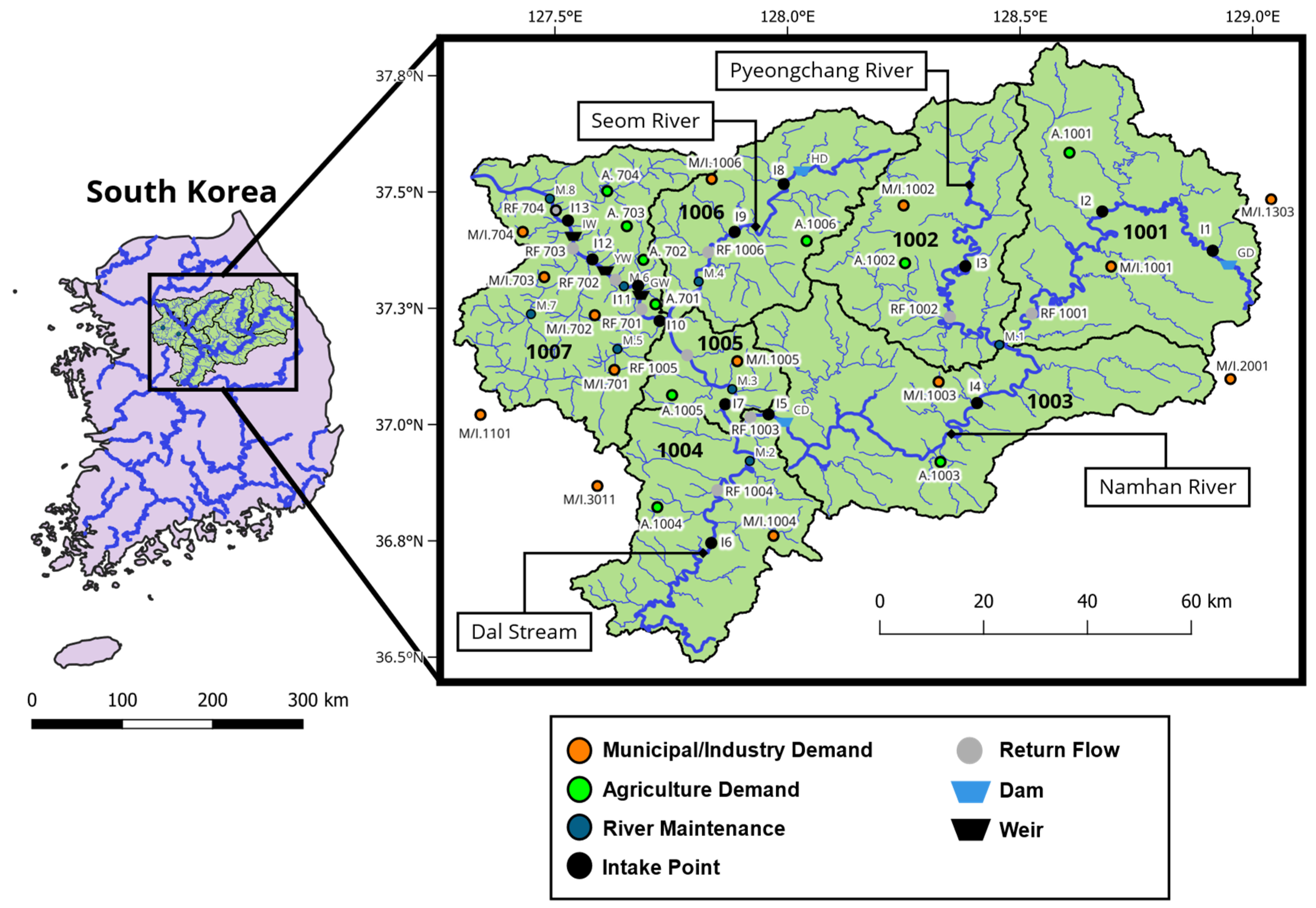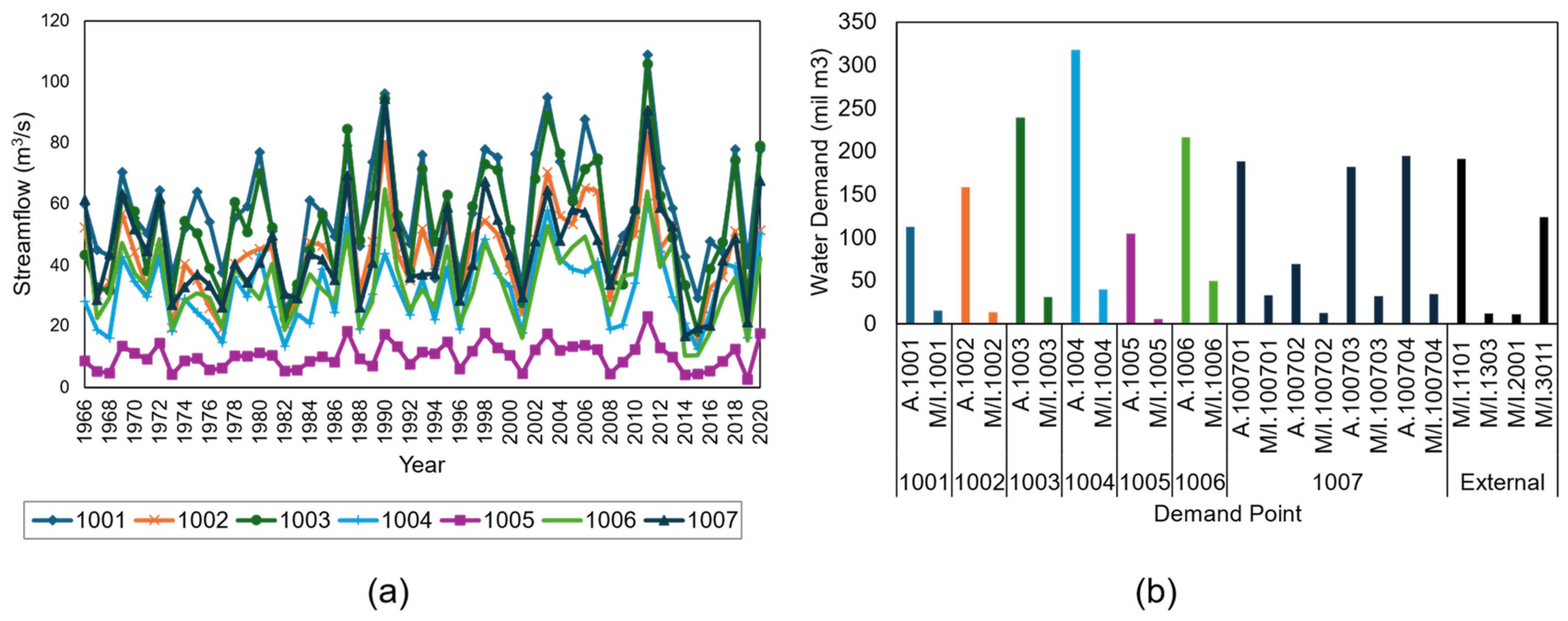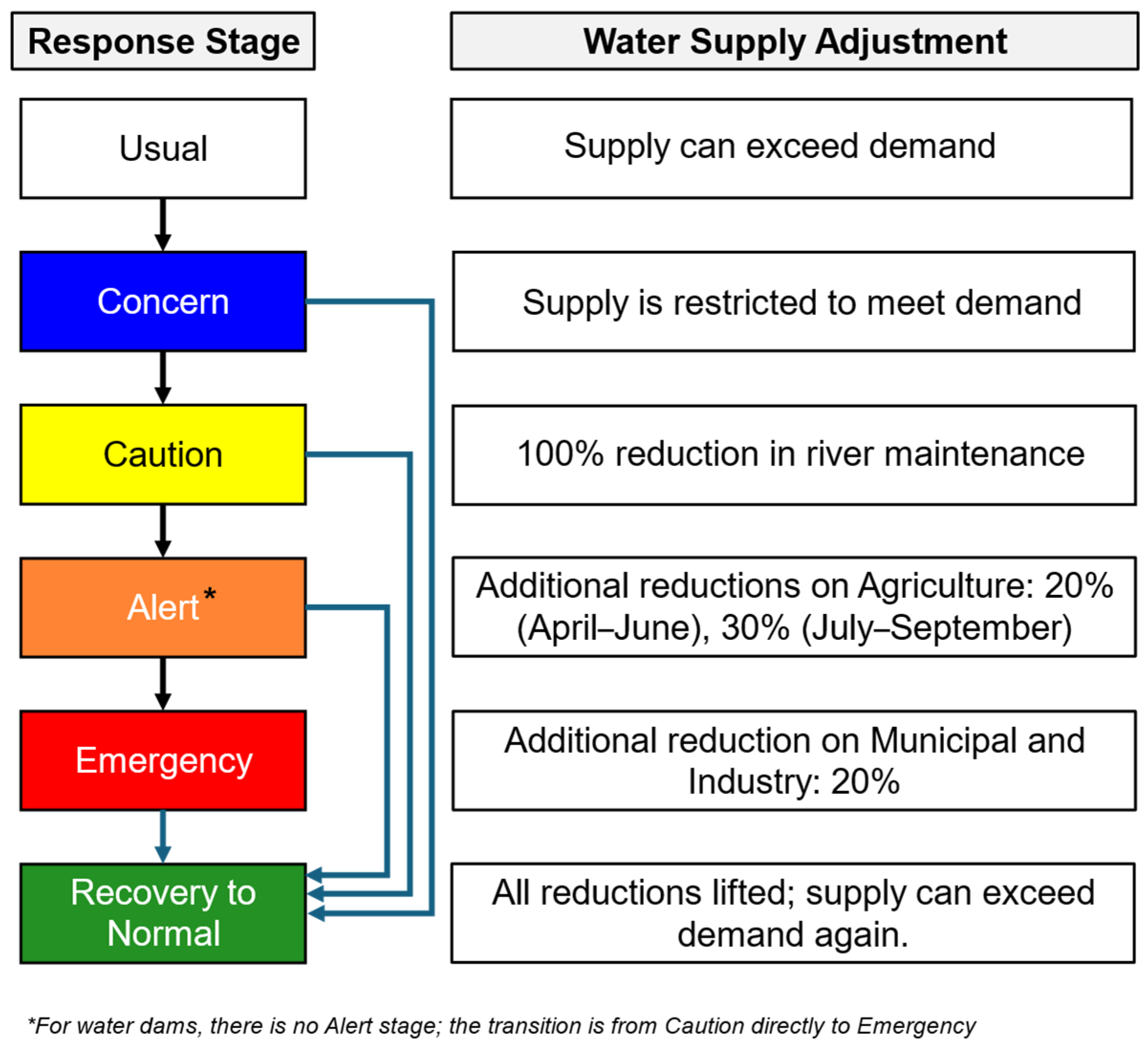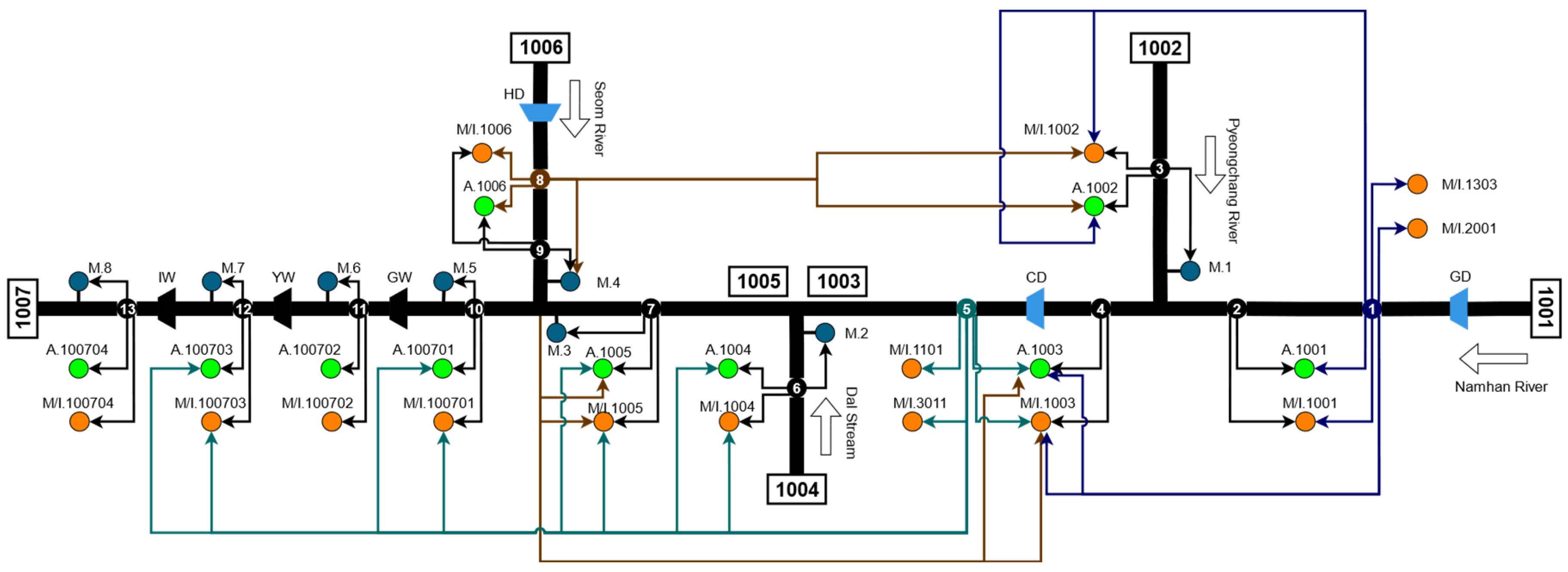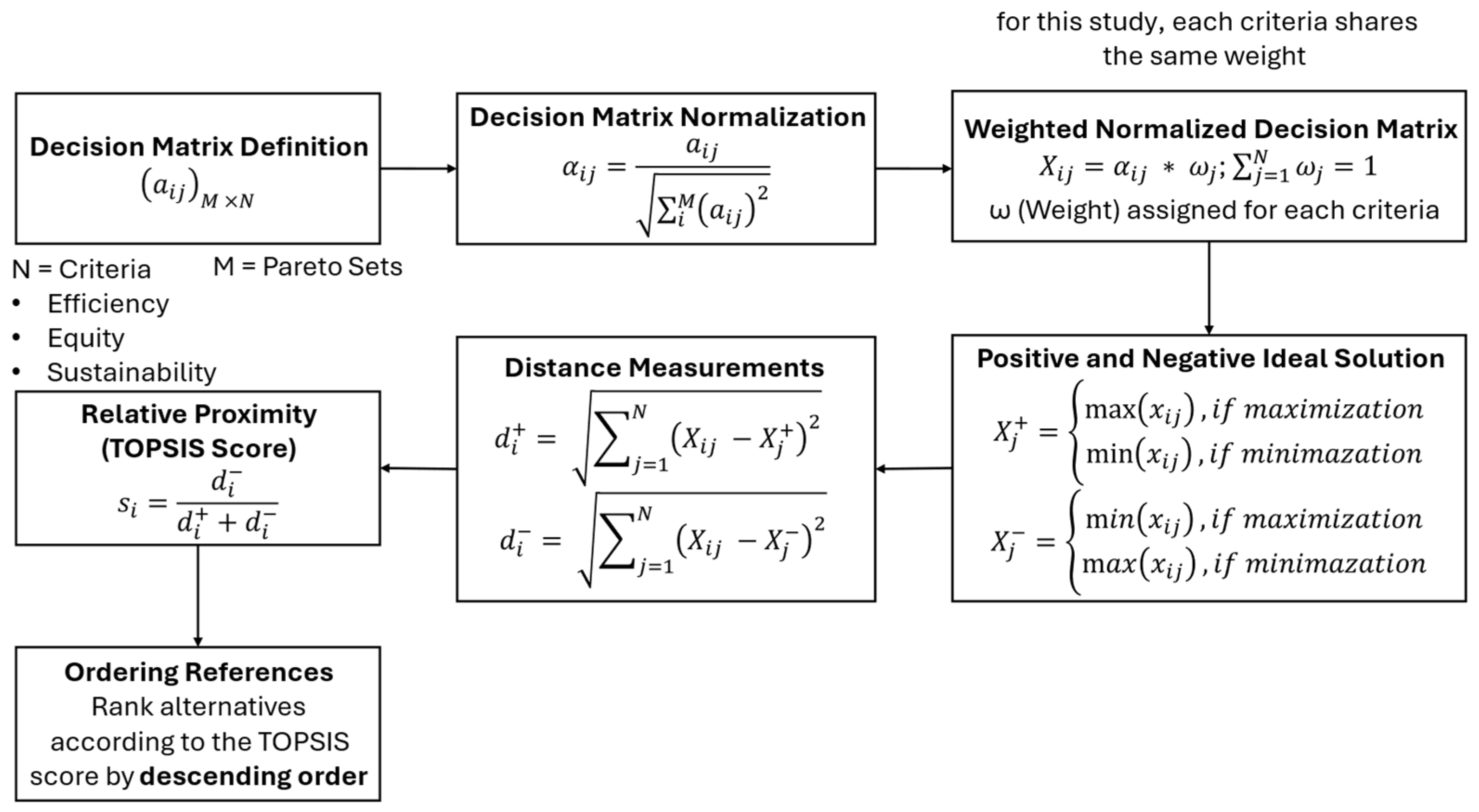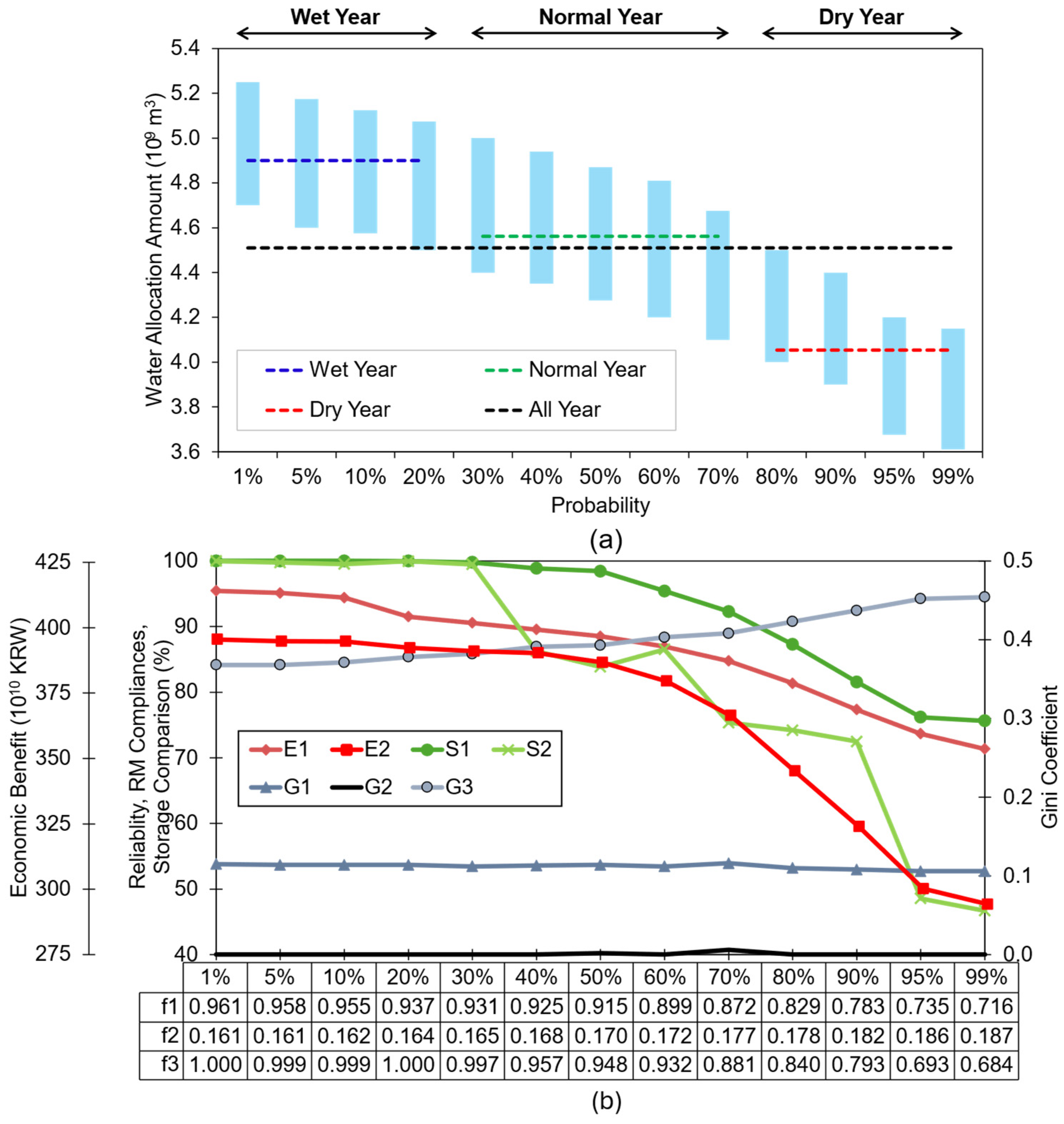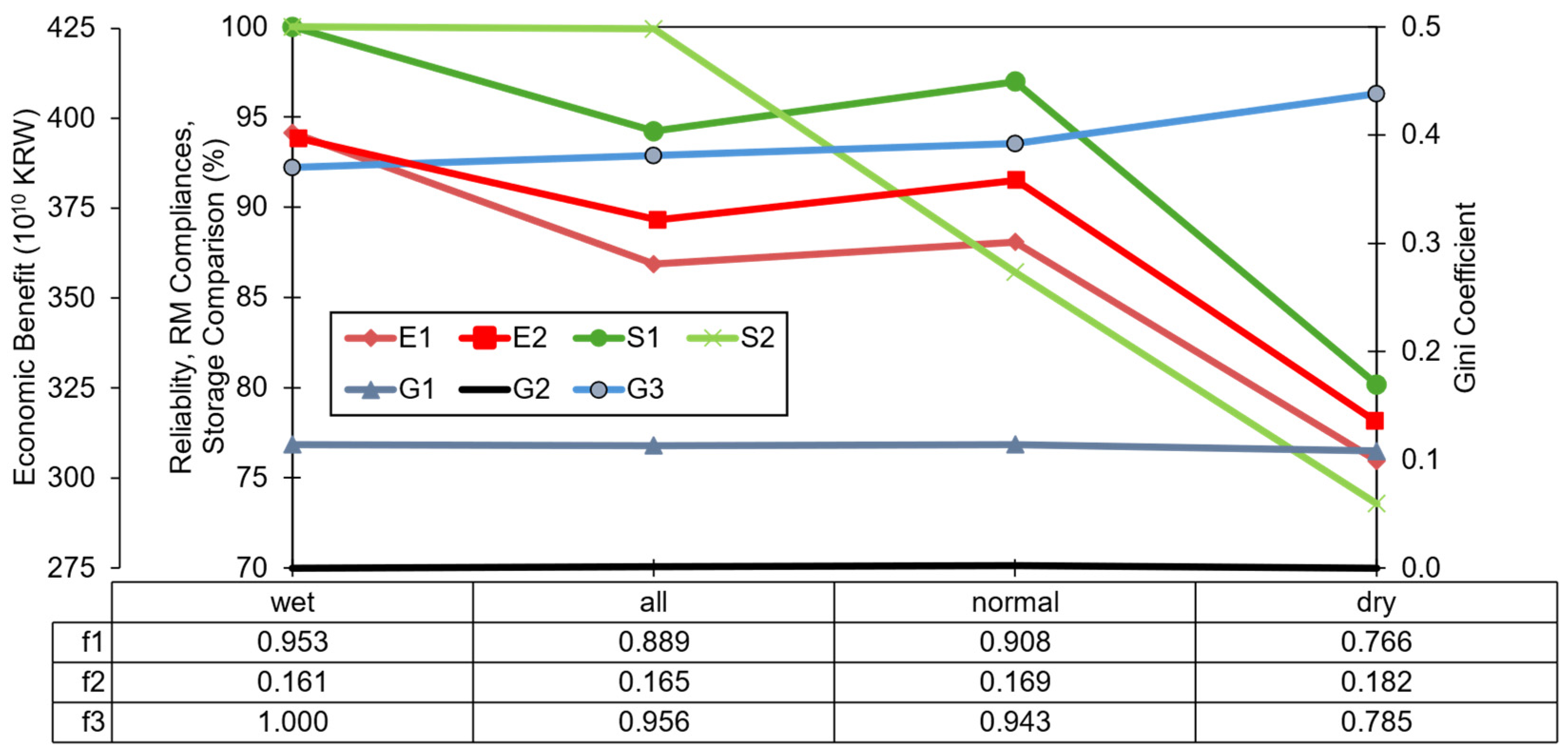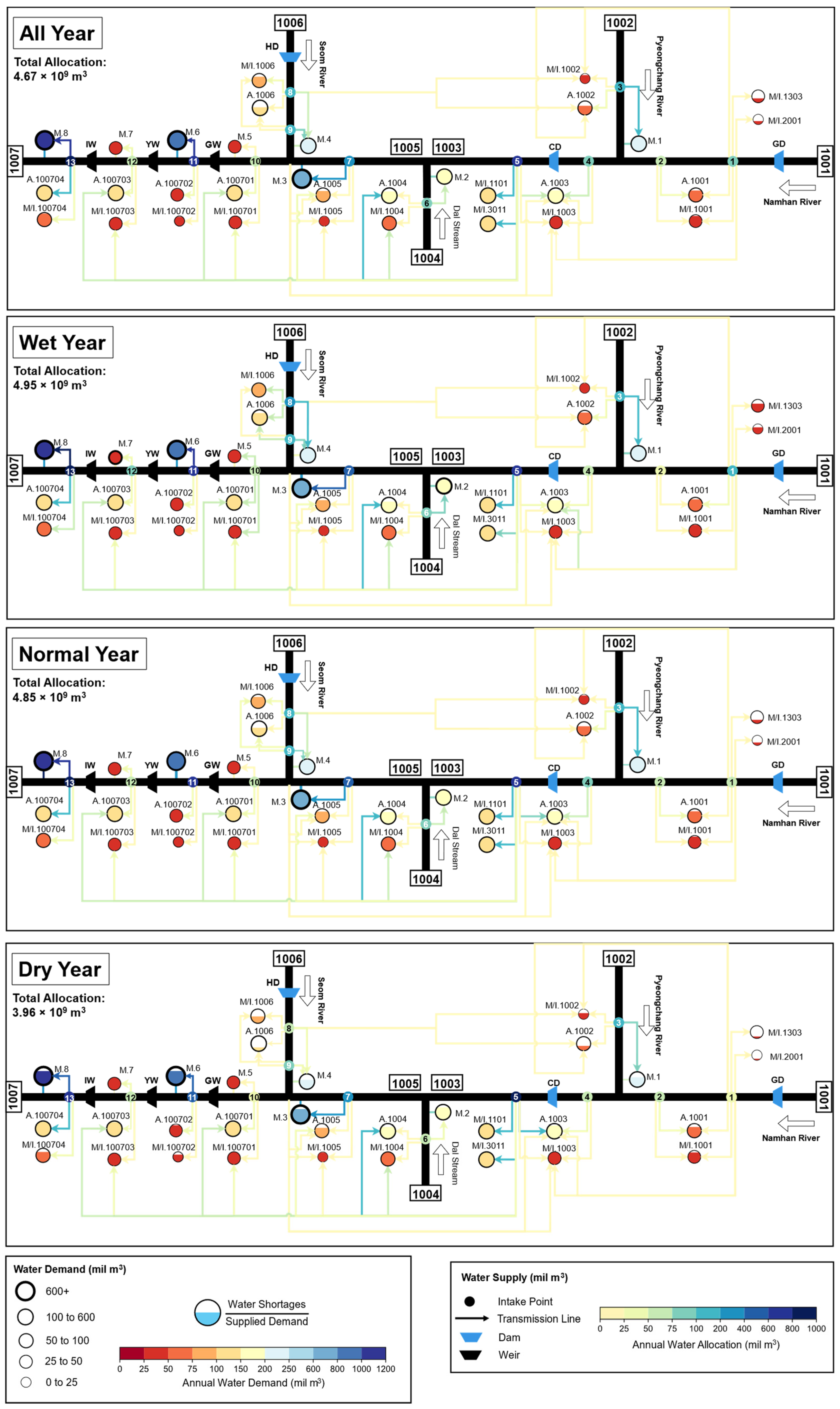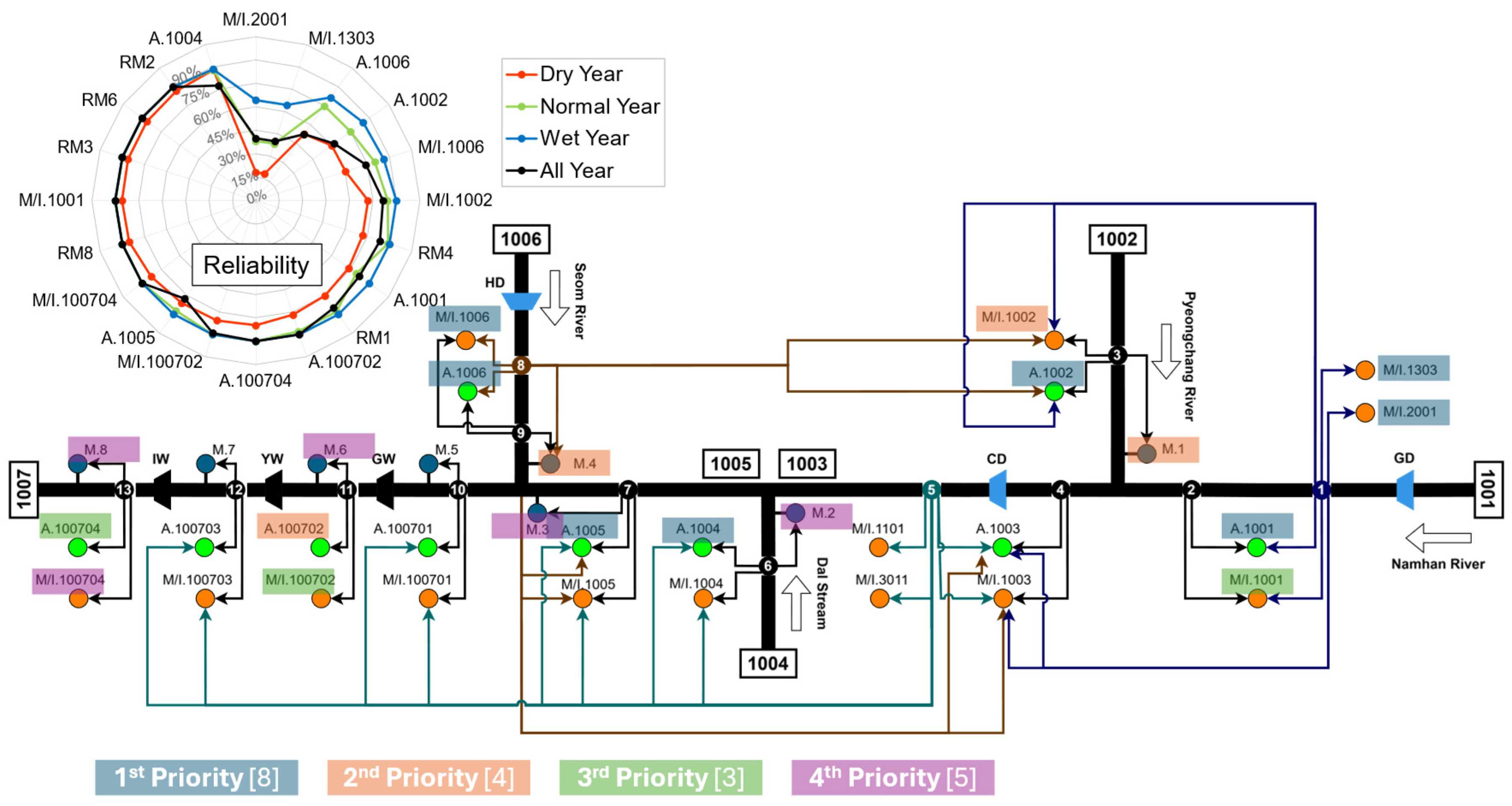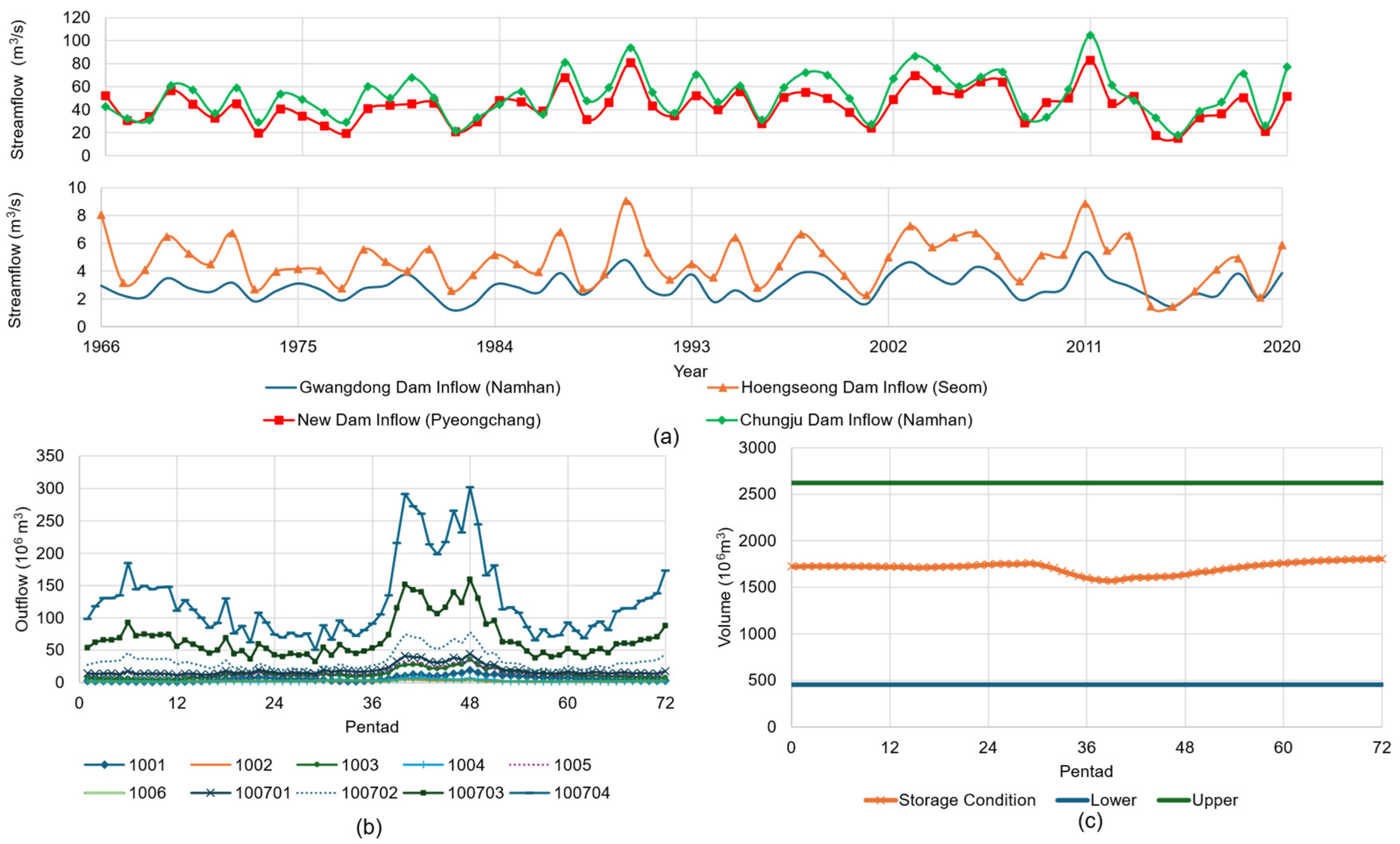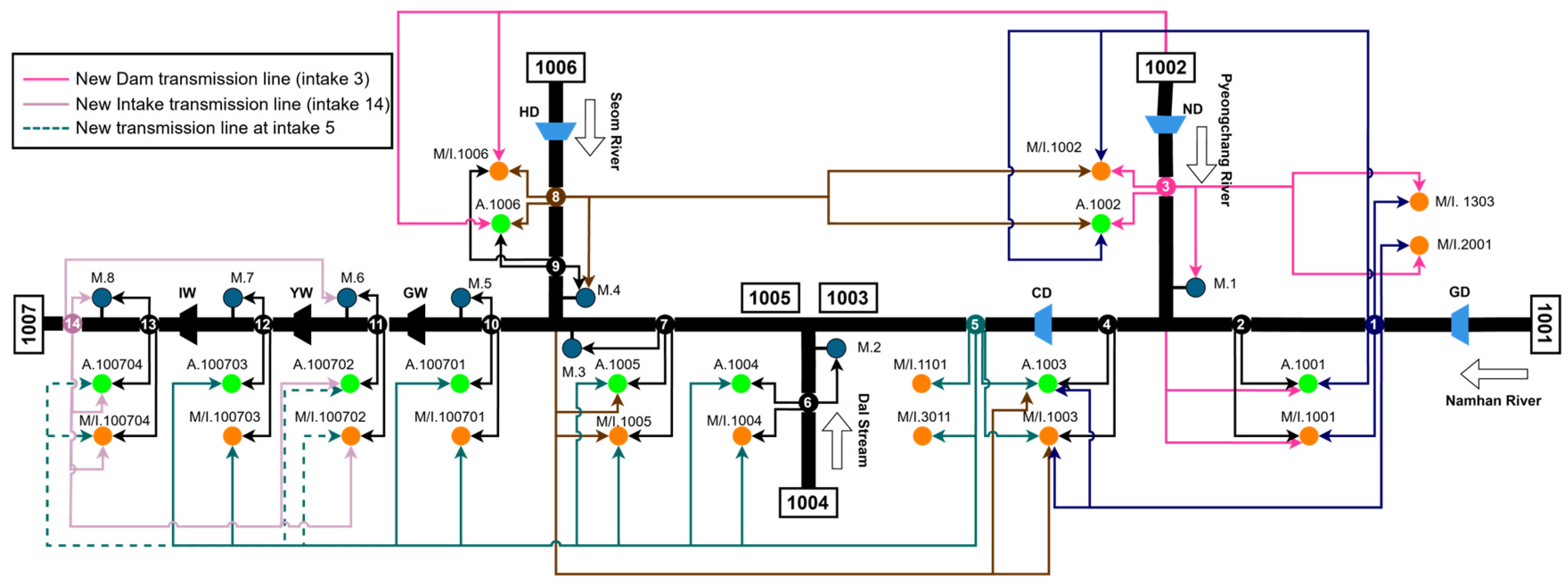1. Introduction
Water is essential for human existence, maintaining ecosystems, supporting agriculture, powering industries, and providing domestic necessities, among other crucial functions. Global water consumption is projected to increase by 55% by 2050 [
1]. Moreover, climate variability poses a risk to water availability [
2,
3]. This has altered the balance between water demand and supply, rendering effective water management an urgent issue [
4,
5]. This has resulted in competition for water resources and potential conflicts between user groups, thereby rendering conventional methods insufficient. An integrated approach that considers all aspects of water use and management (from supply and demand to economic and environmental impacts) is required to maximize efficiency and equity without compromising sustainability [
6]. Water allocation is a vital component of water resource management. Therefore, adopting this strategy is essential for achieving a more flexible and resilient allocation that can respond better to fluctuations in supply and demand.
Recent studies have evaluated the optimization of water allocation [
7,
8]. Optimal water-allocation efficiency is achieved when a limited water supply satisfies economic and human needs [
9]. Evidence of increasing economic focus is the shift in water allocation priorities from agriculture to the municipal and industrial sectors, where higher economic returns are more evident [
10]. Several studies have aimed to optimize water allocation with economic efficiency as the primary objective.
For example, Freire-González et al. [
11] evaluated water allocation strategies under climate change and policy variations to minimize the economic impacts. Building on this, Sherafatpour et al. [
12] emphasized the need to allocate limited water to different agricultural sectors while maximizing economic efficiency and net profit. Jeong et al. [
13] emphasized the need to maximize economic benefits while ensuring supply reliability. Meanwhile, Vichete et al. [
14] focused on minimizing the cost of priority-based penalty.
Equity in water allocation ensures unbiased access to water for each user [
15]. In recent decades, studies on water allocation have increasingly focused on equity, although economic factors have conventionally been the primary focus [
16]. Habibi Davijani et al. [
9] connected equity to job creation. Tian et al. [
17] established equitable water allocation via conflict-resolution methods. Other studies employed the Gini coefficient to assess equity in water supply, distribution, and irrigation by comparing water supply with factors such as economic benefits, population, gross domestic product (GDP), and demand [
15,
18,
19,
20]. In addition, some studies have used evapotranspiration as a proxy for water use, comparing it across different areas to evaluate spatial equity in crop water use [
21].
Sustainability is another critical component of an integrated water allocation approach. It involves maintaining water availability for future generations while preserving ecological and environmental systems [
22]. Several studies have attempted to implement this principle in water allocation models. For example, Dadmand et al. [
23] optimized the water distribution among users while prioritizing renewable sources by minimizing groundwater use. Ye et al. [
24] and Zeng et al. [
25] evaluated water transfer considerations and weighed the economic benefits and environmental impacts. Li et al. [
26] used an equity-focused approach to irrigation-water allocation while addressing greenhouse gas emissions from fertilizer use. Furthermore, numerous studies emphasize the need to comply with river maintenance flow as a component of sustainability [
18,
19,
27,
28].
Although integrated water allocation is an important research area, it is crucial to acknowledge the role of uncertainty in this context. Several studies have addressed this factor, with a growing focus on stochastic models that incorporate uncertainty in supply and demand. For example, Berbel et al. [
29] evaluated a stochastic approach by addressing yield variability and its impact on water allocation decisions. Other studies, such as Xu et al. [
18], Li et al. [
26], and Chen et al. [
30], examined fluctuating water supply conditions. Xu et al. [
31], Liu et al. [
32], and Liu et al. [
33] utilized dynamic models to reflect varying water resources and demand conditions.
Although many studies have investigated efficiency, equity, and sustainability individually or in pairs, research that fully integrates these three in water allocation remains limited [
15,
19]. Few studies have comprehensively considered efficiency, equity, and sustainability within a stochastic framework, particularly under varying water availability conditions [
18,
28]. This deficiency emphasizes the need for a holistic approach that incorporates stochastic modeling to better address the fluctuations in water supply and demand; this, in turn, highlights the need for further research in this field.
This study aimed to address this gap by proposing a multi-objective optimization water allocation model that integrates efficiency, equity, and sustainability. Economic benefits and reliability represent efficiency, the Gini coefficient measures equity (considering water supply versus population, GDP, and available water sources), and river maintenance compliance and dam storage ratios quantify sustainability. The model was applied to the Namhan River Basin in South Korea. The objectives of this study were to (1) identify vulnerable areas that encounter water shortages under varying climatic conditions, (2) provide water allocation strategies for different hydrological conditions (dry, normal, and wet), and (3) recommend water-supply infrastructure improvements to mitigate vulnerabilities, particularly during dry periods. Stochastic simulations accounted for fluctuations in the water supply, whereas the demand was addressed using projected data for the year 2030. Efficiency, equity, and sustainability were integrated through non-dominated sorting genetic algorithm II (NSGA-II) optimization. TOPSIS was used to select the most balanced solution among the obtained Pareto-optimal sets. This comprehensive approach aimed at providing a more resilient water-allocation framework under uncertainty.
The remainder of this paper is organized as follows.
Section 2 outlines the materials and methods used for the optimization and stochastic modeling.
Section 3 presents and discusses the results.
Section 4 presents concluding remarks and summarizes the findings.
2. Materials and Methods
In this study, a multi-objective optimal water allocation model was developed by integrating stochastic modeling to address uncertainty. The first step involved addressing the uncertainty in the water supply using stochastic simulations to generate streamflow for different hydrological probabilities. Multi-objective optimization was then applied to these streamflow scenarios to produce Pareto sets of water allocation strategies under varying conditions. Finally, the model focused on two key applications: (1) defining optimal water allocation strategies for different hydrological conditions and identifying vulnerable areas and (2) planning water-supply infrastructure improvements to mitigate vulnerabilities during dry conditions.
Figure 1 illustrates the proposed framework.
2.1. Study Area
The proposed model was implemented for the Namhan River Basin in South Korea (
Figure 2). The basin has a total length of 375 km and covers an area of 12,407 km
2. It is a tributary of the Han River Basin and is adjacent to the Bukhan (North Han) River Basin. Located in the eastern region of South Korea, it encompasses several provinces, including Gyeonggi, Gangwon, and North Chungcheong. The basin is divided into seven sub-basins (1001–1007). Sub-basin 1007 features three large weirs: Gangcheon, Yeoju, and Ipo. Sub-basin 1007 was divided into four sections (100701–100704) to account for the weirs. The basin contains three major dams: the Gwangdong, Chungju, and Hoengseong dams. Chungju was the main dam [
34].
The Namhan River is the primary river in this basin. It is supplemented by tributaries such as the Pyeongchang River, Dal Stream, and Seom River. The region experiences an annual mean temperature of 12 °C, with an average precipitation of 1167 mm [
35]. Approximately two-thirds of the annual precipitation occurs during the summer monsoon season (from mid-June to mid-September).
2.2. Data Collection
The data collected in this study encompass various water sources and demands for simulating water allocation. Data on water supply sources primarily included streamflow from 1966 to 2020 [
35].
Figure 3a shows the annual streamflow during this period. Groundwater usage in South Korea accounts for 3% of the total water use. The breakdown of groundwater usage is as follows: municipal (43%), agricultural (52%), industrial (4%), and other (1%) [
36]. Although not directly included in the simulation, this groundwater usage was factored into the initial demand and deducted from the groundwater supply before the simulation. In South Korea, 65% of municipal/industrial (M/I) water and 35% of agricultural (A) water are discharged into rivers downstream of demand sites as return flow [
37].
In addition, the simulation incorporated data from dams and weirs, including metrics such as storage capacity (
Table 1) and water-level storage curves [
34]. The dams follow standardized guidelines for drought response and are divided into five levels. When the water level of the dam reaches a certain threshold, water-supply adjustments are made according to the reduction plan for that stage. This is illustrated in
Figure 4 [
38].
WAMIS [
34] provides sector-wise demand data from 1965 to 2020. These reveal an average annual demand of 203 million cubic meters for municipal use, 106 million cubic meters for industry, and 1777 million cubic meters for agriculture in the basin.
Figure 3b illustrates the average annual demand for each sector. Eight river maintenance sites (M.1–M.8) within the basin had flow values of 7.73, 5.03, 23.1, 7.57, 0.96, 30.0, 1.41, and 32.5 m
3/s to be maintained. The locations of these sites are shown in
Figure 2 [
39].
Socioeconomic data, including GDP and population statistics [
40], were also used in equity calculations.
Figure 5 visually represents the water-supply scheme determined from the water-supply area data provided by K-Water [
41] and the GIS data from MOE & NIER [
42].
2.3. Uncertainties
This study addressed two main uncertainties: demand and supply. The demand uncertainties were captured through the variations in water demand for 2030 based on K-Water [
43]. By 2030, municipal and industrial water usage is likely to increase by 4.7%, whereas agricultural demand is likely to decrease by 5.9% (using 2020 demand as the baseline). This also indicates that river maintenance flow would be the most vulnerable during the dry season in 2030. The reduction in agricultural demand is likely due to a reduction in cultivated areas (particularly rice fields).
Supply uncertainties are driven by variations in water availability, which are determined by different streamflow inflow levels. In hydrology, these variations are expressed using exceedance probabilities. Here, lower probabilities indicate higher inflows, and higher probabilities correspond to lower inflows. Stochastic modeling was used to capture and simulate these variations.
2.3.1. Data Grouping
The streamflow data consist of 55 years of daily measurements. The daily data were organized into 72 groups, each representing the streamflow for the same pentad (five-day period) across different years. These groups span the entire year from January (01-P1, …, 01-P6) to December (12-P1, …, 12-P6).
2.3.2. Goodness-of-Fit Testing
The probabilistic streamflow distributions in this study were modeled using four distribution types: normal, Pearson III, Log Pearson III, and Gumbel type I.
Table 2 presents the probability density functions (PDFs) for each distribution [
44]. The empirical probability for each of the 72 pentad inflow groups was calculated using the following equation [
45]:
where
is the empirical probability,
is the order, and
is the number of data points. The theoretical probability was then calculated using the cumulative distribution function (CDF) of each distribution. The SciPy Python package (version 1.13.1) was used for CDF calculations [
46,
47]. The Kolmogorov–Smirnov [
48] test was conducted to determine the best-fitting probability distribution. The maximum vertical deviation between the empirical and theoretical probabilities was calculated using the following equation:
where
is the maximum deviation, and
is the theoretical probability. This study used a 95% significance level of confidence. This implies that the distribution had a good fit when
was less than the critical value of 0.1833 (for n = 55, alpha = 0.05). The distribution with the minimum
was selected as the best-fitting distribution.
2.3.3. Stochastic Inflow Generation
After identifying the best-fitting distribution for each pentad, stochastic inflow scenarios were generated using a Monte Carlo simulation [
49]. Ten thousand random streamflow values were simulated for each pentad based on the selected distribution. This approach enabled the modeling of potential inflows across various scenarios, thereby capturing the inherent uncertainty in future inflows.
2.3.4. Derivation of Inflow Probability
From the generated inflow values for each pentad, 13 probabilities were derived at 1%, 5%, 10%, 20%, 30%, 40%, 50%, 60%, 70%, 80%, 90%, 95%, and 99%. Probabilistic streamflow estimates provide a range of inflow rates under various hydrological conditions. The generated stochastic inflow data (categorized by probability) were subsequently used as inputs for the water allocation models. These models incorporate various hydrological scenarios (dry, normal, and wet years) based on probability distributions to assess the water availability and support decision-making processes for future water allocation strategies.
2.4. Optimization
The optimization in this study integrates the objectives of efficiency, equity, and sustainability using multi-objective NSGA-II. NSGA-II [
50] was implemented to optimize a one-year water allocation plan for each pentad with a population size of 300 and 250 generations. This was facilitated using the Pymoo library [
51]. The decision variable for optimization was the water allocation at each intake point, with a total of 13 intake points over 72 pentads. This yielded 936 decision variables (13 intake points × 72 pentads). The 13 intake points are indicated in
Figure 2 and
Figure 5.
Optimization was applied to 18 simulations, each representing varying hydrological conditions and demands, as follows:
Simulations 1 and 2 were used to compare the enhancement of the water allocation strategies with and without optimization under dry and wet conditions. In 2015, South Korea experienced a severe drought [
52]. Meanwhile, in 2020, it encountered unusually wet conditions [
53]. Therefore, the inflows and demands for these two years were used in Simulations 1 and 2 to demonstrate the performance of the optimization model in contrasting hydrological years;
Simulations 3–15 focused on probability-based scenarios, incorporating stochastic inflows derived from the uncertainty analysis step using 13 probabilities. These simulations were paired with the projected demand data for 2030 to evaluate different water allocation strategies across various hydrological conditions. These results were integral to Application 1, which aimed to define optimal water allocation strategies for future hydrological conditions;
Simulations 16–18 addressed extreme conditions using the minimum, median, and maximum inflows based on historical data from 1966 to 2020, in conjunction with the projected demand for 2030.
These simulations were critical for determining the vulnerable areas in Application 1 to support the goal of Application 2 (recommend water-supply infrastructure improvements).
To validate the model, the results from the optimized (with) and non-optimized (without) scenarios were compared in Simulations 1 and 2. The non-optimized scenario served as a baseline in which no allocation ratios were applied. This enabled the unconstrained drawing of water to satisfy the demand without considering downstream users. The optimized scenario incorporated allocation ratios to balance efficiency, equity, and sustainability in water distribution.
Real-world operational data were not used for validation because of the complexity of actual systems. These systems involve extensive networks of demand points, operational priorities, and dynamic adjustments that are beyond the scope of the simplified conceptual framework proposed in this study. Rather, validation was conducted through internal consistency examinations and scenario-based comparisons using probabilistic inflows generated from stochastic simulations. The robustness of the model was demonstrated under dry, normal, and wet conditions and the performance was assessed using efficiency, equity, and sustainability metrics.
2.4.1. Decision Variable
The decision variable in this study was the water withdrawal from each intake point. However, as illustrated in
Figure 5, each intake point supplies water to multiple demand points. A prioritization rule was applied to allocate water to demand points. This rule considers the following three factors:
Number of supplies: Priority is given to the demand points supplied by the least number of suppliers. This ensures that the least-supplied areas are addressed first;
Demand sectors: In line with South Korea’s national water management priorities, the municipal and industrial sectors are prioritized over the agricultural sectors. These, in turn, are prioritized over river maintenance;
Location: Demand points located closer to the intake point (starting from the inner sub-basin) are prioritized before moving to the inner basin and then to the outer basin.
The final water allocation from each intake point to each demand point is determined by integrating these factors. The following equations describe how water supply is allocated to different demand points for a given intake (i.e., Intake X) at time .
The available water supply for Intake X is calculated based on the supply ratio (
) from the decision variable and the water demand at each intake point. This is shown in Equation (3):
where
is the water demand, and
is the number of demand points supplied from intake X.
Each demand point is assigned a priority value,
, derived from several prioritization rules. These rules reflect different factors, such as the amount of supply, demand sectors, location, and vulnerability (in certain cases). The ratio of the sum of the
-th elements (demand point) across all prioritization rules to the sum of all elements across all rules determines the priority for each demand point; this is shown in Equation (4):
where
is the number of applicable rules. The individual rules are as follows:
(numbers of supply rankings): ranking of numbers of available supplies;
(demand sectors): prioritization is based on the type of demand sector
- ⚬
1 for municipal/industry;
- ⚬
2 for agriculture;
- ⚬
3 for river maintenance;
(location): prioritization based on the location of the demand point
- ⚬
1 for inner sub-basin;
- ⚬
2 for inner basin;
- ⚬
3 for outer basin;
(vulnerable area ranking): ranking system for vulnerable areas (Application 2).
Supplied demand ():
Based on priority rules
and demand
, the demand that can be supplied for each demand point
is calculated as follows:
This value represents the proportion of the original demand that can be satisfied by considering the assigned priority.
2.4.2. Objective Function
The goal was to maximize economic benefits and water supply reliability and was formulated as follows:
where
denotes the water supply reliability, and
represents the economic benefit. These two objectives have equal weight.
is calculated as follows:
is the total number of simulation periods (i.e., 72 pentads);
is the weight according to the demand site priority (municipal = 1.0, industry = 0.75, agriculture = 0.5, and river maintenance = 1.0; municipal to agriculture prioritization aligns with South Korea’s management, whereas river maintenance is weighted at 1.0, emphasizing sustainability) for demand point .
is calculated as follows:
where
represents the economic benefit per unit of water supply (municipal: 1283 KRW/m
3, industry: 5583 KRW/m
3, agriculture: 385 KRW/m
3, and river maintenance: 0 KRW/m
3 [
13]) for demand point
.
In this study, equity referred to unbiased access to water across regions and sectors. The Gini coefficient [
54] was used to quantify this. It is typically used to measure inequality in areas, such as income or wealth within a population. It ranges from zero to one. Here, zero represents complete equality (all individuals or regions receive equal resources), and one represents maximum inequality (one entity receives all resources). This study aimed to minimize the Gini coefficient to maximize equity in water allocation.
In the context of water allocation, this study calculated three Gini coefficients (as proposed by Deng et al. [
19]) and averaged them equally to form the final equity objective. The three Gini coefficients measure inequality based on the following:
Water supply relative to population ();
Water supply relative to GDP ();
Water supply relative to local water sources ().
This study computed Gini coefficients based on seven sub-basins within the basin. This ensured that the equity assessment reflected the water distribution across these defined areas. The equity objective function is as follows:
Water supply (
was calculated as the total annual water supply for each sub-basin, as follows:
The three Gini coefficients were calculated as follows:
Here,
: total number of sub-basins (seven in this case);
: population in sub-basin, ;
: GDP of sub-basin ;
: Total annual available water from local water sources in sub-basin . Here, represents the water available from these sources at each time step , summed over the entire year.
Given that river maintenance is likely to be the most vulnerable sector by 2030, this study placed significant emphasis on assessing compliance with river maintenance standards. Furthermore, the dam storage conditions comprehensively assessed sustainability. The primary aim was to ensure that the river maintenance requirements were satisfied while also evaluating whether the storage capacities of the dams or weirs were being utilized excessively or could recover to their initial levels. River maintenance and dam storage were assigned equal weights in the sustainability objective function, formulated as follows:
where
represents river maintenance compliance, and
represents dam storage recovery.
was calculated as follows:
denotes the total number of river maintenance points, is the supplied water for each river maintenance point at time , and is the river maintenance flow for each point at time .
The dam storage recovery index is calculated as follows:
Here,
If the final storage exceeded the initial storage , it was considered to be one. This indicates that the dam or weir has not been utilized excessively, and that the system has recovered to its initial or better state.
This study incorporated a non-negativity constraint on optimization to ensure that
and
The dam or weir storage was calculated using the following equation:
where
represents storage at time
in the dam or weir (m
3).
denotes the water inflow into the dam or weir at time
(m
3).
refers to the amount of water spilled when the storage exceeds the maximum storage (m
3).
is the amount of water released from the dam or weir (m
3). Finally,
accounts for the evaporation occurring in the dam or weir.
2.5. Multi-Criteria Decision (TOPSIS)
Given that the optimization process generates a large number of results represented as Pareto sets, it is essential to select the most balanced solution from these sets by evaluating how closely each solution aligns with the preferable outcome for all objectives. The TOPSIS method [
55] was used to achieve this. The steps involved in the TOPSIS approach are illustrated in
Figure 6. In this application, uniform weights were assigned to each objective to ensure an unbiased assessment of all criteria in the decision-making process.
2.6. Water Allocation Strategy
The hydrological conditions vary annually. This results in dry, wet, or normal conditions. The standardized precipitation index (SPI) was used to determine hydrological years. It classifies droughts based on SPI values [
56]. Lloyd-Hughes et al. [
57] further analyzed the probability of each SPI category (
Figure 7a). Based on this classification, the inflow generated from the stochastic modeling step can be categorized into wet, normal, and dry years. These have the following probability divisions: probabilities 1%, 5%,10%, and 20% represent wet years; 30%, 40%, 50%, 60%, and 70% indicate normal years; and 80%, 90%, 95%, and 99% denote dry years (
Figure 7b). These groups of inflows were used in Application 1 to inform water allocation strategies for different hydrological years.
After determining the water allocation for each probability using the TOPSIS method, the water allocation for each hydrological year was calculated using the following equation:
represents the water allocation for each hydrological year (), is the number of probabilities at , and is the water allocation at probability .
2.7. Vulnerable Area
To determine vulnerable areas, the average pentad reliability
for each demand point below 90% was utilized and categorized as wet, normal, dry, or all-year. This can be expressed using the following equation:
To obtain broader results, in addition to the probability division shown in
Figure 7b, vulnerable areas were identified by incorporating data from all 18 simulations. The wet years include Simulation 2 (representing the 2020 conditions), Simulations 3–6 (with probabilities of 1%, 5%, 10%, and 20%), and Simulation 18 (representing the all-time maximum). The normal years include Simulations 7–11 (with probabilities of 30%, 40%, 50%, 60%, and 70%) and Simulation 17 (representing the all-time median). The dry years include Simulation 1 (representing the 2015 conditions), Simulations 12–15 (with probabilities of 80%, 90%, 95%, and 99%, respectively), and Simulation 16 (representing the all-time minimum). The “all-year” category encompasses all the 18 simulations.
This approach enabled the identification of areas that consistently experience water shortages even during periods of ample water availability. Therefore, it provides a comprehensive assessment of the vulnerable regions across a wide range of hydrological conditions.
3. Results and Discussion
3.1. With Optimization vs. Without Optimization
Simulation 1 (dry year) and Simulation 2 (wet year) highlight the significant impact of optimization on water allocation. As listed in
Table 3, both reliability and economic benefits increased in both years. Observable improvements occurred in river maintenance, particularly in wet years, when compliance was 100%. In terms of dam and weir storage, optimization significantly enhanced storage management. This was particularly true in wet years when controlled water allocation prevented overuse. The storage performance improved even during dry years. The Gini coefficient reflects progress in equity with improvements in water supply distribution relative to population and GDP. However, regarding local water sources, the marginal increase in the Gini coefficient indicates that optimized water allocation tends to involve drawing more water from outside the sub-basin.
3.2. Optimization Result for Each Streamflow Probability
The results of Simulations 3–15 illustrate the water allocation for each probability, as shown in
Figure 8a. The most balanced solution for the three objectives (efficiency, equity, and sustainability) was identified using the TOPSIS method.
Figure 8b shows the objective function values for each probability simulation. The impact of water availability on the objective functions revealed that higher water availability yielded improved outcomes across all the objectives. The efficiency values range from 0.716 to 0.961, equity (measured by the Gini coefficient) shows values between 0.161 and 0.187, and sustainability scores range from 0.684 to 1.000.
3.3. Application 1: Water Allocation Strategies for Each Condition
The result from a probability-based scenario in
Section 3.2 (which produced the water allocation that accounts for varying hydrological conditions, i.e., wet, normal, and dry years, as well as an “all-year” scenario covering the complete range of probabilities) is depicted in
Figure 9 and
Figure 10.
Figure 9 presents the objective function results, and
Figure 10 shows the water allocation dynamics under various hydrological conditions.
As seen in
Figure 9, the objective function outcomes and water shortages across all conditions were primarily influenced by the available water supply volume. This explains why the wet-year scenario exhibited superior performance across all the evaluated objectives and experienced the least water shortage, whereas the dry-year scenario yielded the lowest objective function values. The “all-year” scenario results were better than the normal-year results, owing to the inclusion of wet-year probabilities, which enhanced the overall outcomes.
As depicted in
Figure 10, in terms of water shortages, M/I.1303 and M/I.2001 consistently encountered the most severe shortages of all the demand points. This was because these demand points were supported only by Intake 1, which experienced low to medium inflow levels in this sub-basin. Even during the dry years, Intake 1 allocated the least amount of water. This issue was addressed in Application 2, which indicated a new water-supply infrastructure in this area. Another significant shortage occurred at M/I.1006 and A.1006, which received the least supply among all the points during the dry years, even though these had a direct supply from Hoengseong Dam. This is because Intake 8 (which supplies these points) was responsible for an excessive number of demand points. This was also considered in Application 2, which focused on water-supply infrastructure planning in this sub-basin.
Regarding the intakes that received the highest water supply in the basin, the top four (Intakes 13, 11, 5, and 7) remained consistently ranked, although their order varied depending on the conditions. Intakes 11 and 13 consistently ranked high because they supplied M.6 and M.8 (the two largest demand points in the basin). Intake 5 is also ranked high because it received a direct supply from the Chungju Dam (the main dam in the basin). Intake 7 followed closely. It is located downstream of Chungju Dam and supports M.3, which is the third-largest demand point.
Intakes 8 and 3 switch roles depending on the condition. Under dry, normal, and all-year conditions, Intake 8 allocated more water than Intake 3. This is reasonable because it also supplies M/I.1002 and A.1002, both of which are supported by Intake 3. During wet periods, Intake 8 (supplied by the Hoengseong Dam) allocated more water. During dry periods, the dam stores water. This causes Intake 3 to allocate more water. Similarly, Intake 1 allocates more water in wet years but supplies the least water during dry conditions. Intake 2, in turn, allocates less during wet periods (because Intake 1 satisfies most of the demand) but allocates more than Intake 1 does in dry years. The other intakes generally exhibited consistent behavior across conditions.
Through Application 1, the dynamic behavior of water allocation among intake points under different streamflow conditions became evident. Despite periods of abundant supply, several demand points continue to experience water shortages. This issue was addressed in Application 2, where further solutions were proposed to improve water management.
3.4. Application 1: Identification of Vulnerable Area
As shown in
Figure 10 and discussed in
Section 3.3, several areas have experienced water shortages under different water supply conditions.
Figure 11 highlights vulnerable areas where reliability falls below 90%. These areas were categorized into four priorities based on the severity of their shortages. Priority includes areas that experience shortages, even during wet years. This indicated that these locations experienced low reliability across all conditions (wet, dry, normal, and all-year). The more frequently an area fell below the 90% reliability threshold, the higher its priority. Based on this prioritization, Application 2 focuses on addressing these high-priority areas to mitigate shortages and improve supply reliability.
3.5. Application 2: Water-Supply Infrastructure Planning
The goal of Application 2 was to mitigate water shortages during dry periods by implementing new infrastructure. To achieve this, this study utilized the dry-period inflow data and water shortages identified in Application 1 to inform the planning process. Although several critical factors were considered, it is important to note that the cost of constructing new infrastructure was not included in this analysis.
Figure 12a–c illustrate the conditions during dry periods. This emphasizes the potential for the development of new infrastructure in these areas.
A comparison of sub-basin 1002 (which currently has no dams) with the inflow from other existing dams (
Figure 12a) indicates that the flow in this sub-basin (Pyeongchang River) is suitable for a new dam. The new dam is intended to address water shortages in priority areas within sub-basins 1001, 1002, and 1006. After assessing the required storage volume and comparing it with existing dams in South Korea, a new dam with a volume of 173 million m
3 was proposed. The dam characteristics, including the upper and lower elevation limits, storage formulas, and drought-stage operation, were similar to those of an existing dam of similar size in South Korea. The initial storage level was set to 70% of the total capacity.
Figure 12b illustrates the outflows for each sub-basin in the downstream section of the basin. This indicates that sub-basin 1007 experienced a substantial outflow. This surplus can be utilized to alleviate water shortages in priority areas within sub-basin 1007. To achieve this, a new intake point (Intake 14) was established to capture and distribute excess water more efficiently. Furthermore,
Figure 12c highlights that the Chungju Dam was underutilized during dry periods. Consequently, a new demand point would be connected to the Chungju Dam to enhance the water supply to priority areas in sub-basin 1007. This would ensure a more effective allocation of available resources.
The development of the proposed water-supply infrastructures (i.e., new dam, new intake point, and new transmission line) is illustrated in
Figure 13. After implementing the new infrastructure, a series of 21 simulations were run to test various combinations of the newly planned infrastructure and adjust the water distribution by disconnecting certain demand points from Intake 8. These adjustments incorporated an additional supply rule. This is a vulnerable area ranking method, as outlined in
Section 3.4. The five best simulations were selected for further analysis.
Table 4 presents the recommended infrastructure additions and modifications to existing network.
The results of these modifications showed significant improvements, as listed in
Table 5. Application 2 effectively mitigated water shortages during dry periods, with efficiency improving from 0.766 to 0.892–0.909. This increase reflects the higher reliability and economic benefits. Sustainability also improved (from 0.785 to 0.853–0.859). Although river maintenance compliance improves at the cost of marginally higher utilization of dam storage (particularly at the Chungju Dam), this is anticipated, given the additional distribution demands placed on it. Therefore, water managers should consider this observation in future operational planning.
Regarding equity (f2), a marginal deterioration occurred compared to Application 1: the Gini coefficient increased marginally from 0.182 to 0.183–0.185. Equity in terms of supply versus GDP remained unbiased, whereas supply versus population and supply versus locally available water access exhibited certain inequalities. This indicates a tendency to draw more water from outside the basin, although the overall changes were minimal. The results represent an unbiased distribution across most demand points.
Overall, Application 2 demonstrated the effectiveness of the recommended infrastructure planning in mitigating dry-period water shortages while enhancing the key objectives of efficiency and sustainability with marginal trade-offs in equity.
4. Conclusions
This study aimed to address water management challenges under future demand and varying hydrological conditions by developing a water allocation model that integrates efficiency, equity, and sustainability. The model uses historical data, demand projections, and stochastic simulations to capture streamflow uncertainty. Multi-objective optimization was applied using NSGA-II. TOPSIS was employed to select the most balanced solution from the Pareto set. The novelty lies in combining these established methods with vulnerability analysis and infrastructure planning to provide actionable insights for water management. This dual focus enhances the theoretical framework and its practical applicability in addressing real-world challenges.
The model evaluated a range of scenarios, including dry, wet, normal, and all-year conditions. Each scenario was simulated with varying water inflow probabilities. Water allocation was optimized to balance efficiency, equity, and quantity sustainability. Simulations 1 (dry) and 2 (wet) were specifically analyzed to demonstrate the effect of optimization. Other simulations examined various probabilities across 13 inflow scenarios to obtain a comprehensive perspective on water availability under uncertain conditions. Simulations 17 and 19 were used to identify vulnerable areas in the system.
Across all the scenarios, the optimization results show significant improvements in efficiency, equity, and sustainability compared with the non-optimized scenario. Efficiency (measured in terms of economic benefits and supply reliability) increased across all conditions. The most significant enhancement occurred during wet years. Equity (represented by a decrease in the Gini coefficient) also improved. The sustainability metrics (particularly river maintenance compliance and dam storage management) showed significant enhancements owing to optimized water allocations. This effectively mitigated water shortages in vulnerable areas.
Despite its contributions, this study has several limitations. It is conceptual and simplifies the real-world complexities. For example, infrastructure costs were excluded, and the model did not incorporate real-life operational data or physical transfer capacities between the intake and demand points. Additionally, groundwater resources were addressed in limited detail by relying only on existing government usage data. These omissions reflect the focus on developing a flexible and scalable framework, rather than replicating a specific operational system.
Future studies can enhance this model by incorporating additional parameters to better reflect real-world systems. This includes integrating the economic costs for infrastructure planning, accounting for physical transfer limitations, and expanding groundwater modeling to improve the accuracy of the uncertainty analysis. Water quality should also be considered when aligning sustainability metrics with broader environmental objectives. Incorporating detailed operational data, such as priority rules for dam releases, will further validate the model and increase its applicability. These enhancements would make the framework more robust and adaptable to diverse water management contexts, thereby ensuring that it remains an effective tool for decision-makers.
In summary, this study contributes to water resource management by developing a comprehensive and adaptable model that integrates stochastic simulations, multi-objective optimization, and vulnerability analyses. This novel approach provides valuable insights into equitable and sustainable water distribution, while laying a foundation for future research aimed at addressing real-world complexities.

